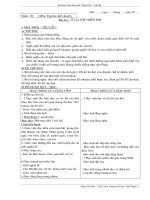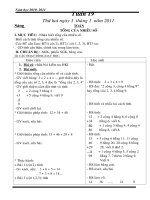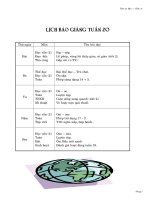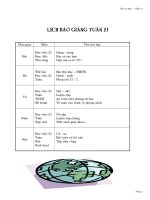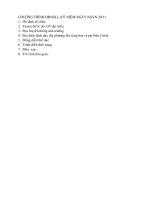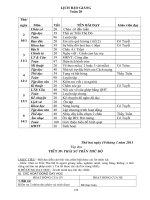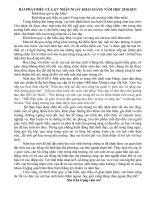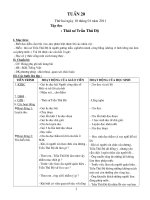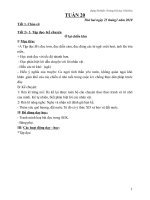Tài liệu Medicare Claims Processing Manual Chapter 20 - Durable Medical Equipment, Prosthetics, Orthotics, and Supplies (DMEPOS) ppt
Bạn đang xem bản rút gọn của tài liệu. Xem và tải ngay bản đầy đủ của tài liệu tại đây (443.63 KB, 96 trang )
Medicare Claims Processing Manual
Chapter 20 - Durable Medical Equipment, Prosthetics,
Orthotics, and Supplies (DMEPOS)
Table of Contents
(Rev. 2629, 01-04-13)
Transmittals for Chapter 20
01 - Foreword
10 - Where to Bill DMEPOS and PEN Items and Services
10.1 - Definitions
10.1.1 - Durable Medical Equipment (DME)
10.1.2 - Prosthetic Devices - Coverage Definition
10.1.3 – Prosthetics and Orthotics (Leg, Arm, Back, and Neck Braces,
Trusses, and Artificial Legs, Arms, and Eyes) - Coverage
Definition
10.1.4 - Payment Definition Variances
10.1.4.1 - Prosthetic Devices
10.1.4.2 - Prosthetic and Orthotic Devices (P&O)
10.2 - Coverage Table for DME Claims
10.3 - Beneficiaries Previously Enrolled in Managed Care Who Return to
Traditional Fee for Service (FFS)
20 - Calculation and Update of Payment Rates
20.1 - Update Frequency
20.2 - Locality
20.3 - Elimination of "Kit" Codes and Pricing of Replacement Codes
20.4 - Contents of Fee Schedule File
20.5 - Online Pricing Files for DMEPOS
30 - General Payment Rules
30.1 - Inexpensive or Other Routinely Purchased DME
30.1.1 - Used Equipment
30.1.2 - Transcutaneous Electrical Nerve Stimulator (TENS)
30.2 - Items Requiring Frequent and Substantial Servicing
30.2.1 - Daily Payment for Continuous Passive Motion (CPM) Devices
30.3 - Certain Customized Items
30.4 - Other Prosthetic and Orthotic Devices
30.5 - Capped Rental Items
30.5.1- Capped Rental Fee Variation by Month of Rental
30.5.2 - Purchase Option for Capped Rental Items
30.5.3 - Additional Purchase Option for Electric Wheelchairs
30.5.3.1 - Exhibits
30.5.4 - Payments for Capped Rental Items During a Period of Continuous
Use
30.5.5 - Payment for Power-Operated Vehicles that May Be Appropriately
Used as Wheelchair
30.6 - Oxygen and Oxygen Equipment
30.6.1 - Adjustments to Monthly Oxygen Fee
30.6.2 - Purchased Oxygen Equipment
30.6.3 - Contents Only Fee
30.6.4 - DMEPOS Clinical Trials and Demonstrations
30.7 - Payment for Parenteral and Enteral Nutrition (PEN) Items and Services
30.7.1 - Payment for Parenteral and Enteral Pumps
30.7.2 - Payment for PEN Supply Kits
30.8 - Payment for Home Dialysis Supplies and Equipment
30.8.1 - DME MAC and A/B MAC Determination of ESRD Method
Selection
30.8.2 - Installation and Delivery Charges for ESRD Equipment
30.8.3 – Elimination of Method II Home Dialysis
30.9 - Payment of DMEPOS Items Based on Modifiers
40 - Payment for Maintenance and Service for Non-ESRD Equipment
40.1 - General
40.2 - Maintenance and Service of Capped Rental Items
40.3 - Maintenance and Service of PEN Pumps
50 - Payment for Replacement of Equipment
50.1 - Payment for Replacement of Capped Rental Items
50.2 - Intermediary Format for Durable Medical Equipment, Prosthetic, Orthotic
and Supply Fee Schedule
50.3 - Payment for Replacement of Parenteral and Enteral Pumps
50.4 - Payment for Replacement of Oxygen Equipment in Bankruptcy Situations
60 - Payment for Delivery and Service Charges for Durable Medical Equipment
80 - Penalty Charges for Late Payment Not Included in Reasonable Charges or Fee
Schedule Amounts
90 - Payment for Additional Expenses for Deluxe Features
100 - General Documentation Requirements
100.1 - Written Order Prior to Delivery
100.1.1 - Written Order Prior to Delivery - HHAs
100.2 - Certificates of Medical Necessity (CMN)
100.2.1 - Completion of Certificate of Medical Necessity Forms
100.2.2 - Evidence of Medical Necessity for Parenteral and Enteral
Nutrition (PEN) Therapy
100.2.2.1 - Scheduling and Documenting Certifications and
Recertifications of Medical Necessity for PEN
100.2.2.2 - Completion of the Elements of PEN CMN
100.2.2.3 - DMERC Review of Initial PEN Certifications
100.2.3 - Evidence of Medical Necessity for Oxygen
100.2.3.1 - Scheduling and Documenting Recertifications of
Medical Necessity for Oxygen
100.2.3.2 - HHA Recertification for Home Oxygen Therapy
100.2.3.3 - Contractor Review of Oxygen Certifications
100.3 - Limitations on DMERC Collection of Information
100.4 - Reporting the Ordering/Referring NPI on Claims for DMEPOS Items
Dispensed Without a Physician's Order
110 - General Billing Requirements - for DME, Prosthetics, Orthotic Devices, and
Supplies
110.1 - Billing/Claim Formats
110.1.1 - Requirements for Implementing the NCPDP Standard
110.1.2 - Certificate of Medical Necessity (CMN)
110.1.3 - NCPDP Companion Document
110.2 - Application of DMEPOS Fee Schedule
110.3 - Pre-Discharge Delivery of DMEPOS for Fitting and Training
110.3.1 - Conditions That Must Be Met
110.3.2 - Date of Service for Pre-Discharge Delivery of DMEPOS
110.3.3 - Facility Responsibilities During the Transition Period
110.4 - Frequency of Claims for Repetitive Services (All Providers and
Suppliers)
110.5 - DMERCS Only - Appeals of Duplicate Claims
120 - DMERCs – Billing Procedures Related To Advanced Beneficiary Notice (ABN)
Upgrades
120.1 - Providing Upgrades of DMEPOS Without Any Extra Charge
130 - Billing for Durable Medical Equipment (DME) and Orthotic/Prosthetic Devices
130.1 - Provider Billing for Prosthetic and Orthotic Devices
130.2 - Billing for Inexpensive or Other Routinely Purchased DME
130.3 - Billing for Items Requiring Frequent and Substantial Servicing
130.4 - Billing for Certain Customized Items
130.5 - Billing for Capped Rental Items (Other Items of DME)
130.6 - Billing for Oxygen and Oxygen Equipment
130.6.1 - Oxygen Equipment and Contents Billing Chart
130.7 - Billing for Maintenance and Servicing (Providers and Suppliers)
130.8 - Installment Payments
130.9 - Showing Whether Rented or Purchased
140 - Billing for Supplies
140.1 - Billing for Supplies and Drugs Related to the Effective Use of DME
140.2 - Billing for HHA Medical Supplies
140.3 - Billing DMERC for Home Dialysis Supplies and Equipment
150 - Institutional Provider Reporting of Service Units for DME and Supplies
160 - Billing for Total Parenteral Nutrition and Enteral Nutrition
160.1 - Billing for Total Parenteral Nutrition and Enteral Nutrition Furnished to
Part B Inpatients
160.2 - Special Considerations for SNF Billing for TPN and EN Under Part B
170 - Billing for Splints and Casts
190 - Contractor Application of Fee Schedule and Determination of Payments and Patient
Liability for DME Claims
200 - Automatic Mailing/Delivery of DMEPOS
210 - CWF Crossover Editing for DMEPOS Claims During an Inpatient Stay
211 -SNF Consolidated Billing and DME Provided by DMEPOS Suppliers
211.1 - General Information
220 - Appeals
230 – DMERC Systems
300 – New Systems Requirements
01 - Foreword
(Rev. 980, Issued: 06-14-06, Effective: 10-01-06, Implementation: 10-02-06)
42 CFR 400.202
This chapter provides general instructions on billing and claims processing for durable
medical equipment (DME), prosthetics and orthotics (P&O), parenteral and enteral
nutrition (PEN), and supplies. Coverage requirements are in the Medicare Benefit Policy
Manual and the National Coverage Determinations Manual.
These instructions are applicable to services billed to the carrier, durable medical
equipment regional carrier (DMERC), intermediary (FI), and regional home health
intermediary (RHHI) unless otherwise noted.
The DME, prosthetic/orthotic devices (except customized devices in a SNF), supplies and
oxygen used during a Part A covered stay for hospital and skilled nursing facility (SNF)
inpatients are included in the inpatient prospective payment system (PPS) and are not
separately billable.
In this chapter the terms provider and supplier are used as defined in 42 CFR 400.202.
• Provider means a hospital, a CAH, a skilled nursing facility, a comprehensive
outpatient rehabilitation facility, a home health agency, or a hospice that has in
effect an agreement to participate in Medicare, or a clinic, a rehabilitation agency,
or a public health agency that has in effect a similar agreement but only to furnish
outpatient physical therapy or speech-language pathology services, or a
community mental health center that has in effect a similar agreement but only to
furnish partial hospitalization services.
Of these provider types only hospitals, CAHs, SNFs, and HHAs would be able to
bill for DMEPOS; and for hospitals, CAHs, and SNFs usually only for
outpatients. Any exceptions to this rule are discussed in this chapter.
• Supplier means a physician or other practitioner, or an entity other than a provider
that furnishes health care services under Medicare.
A DMEPOS supplier must meet certain requirements and enroll as described in
Chapter 10 of the Program Integrity Manual. A provider that enrolls as a supplier
is considered a supplier for DMEPOS billing. However, separate payment
remains restricted to those items that are not considered included in a PPS rate.
Unless specified otherwise the instructions in this chapter apply to both providers an
suppliers, and to the contractors that process their claims.
10 - Where to Bill DMEPOS and PEN Items and Services
(Rev. 1603, Issued: 09-26-08, Effective: 10-27-08, Implementation: 10-27-08)
Skilled Nursing Facilities, CORFs, OPTs, and hospitals bill the FI for prosthetic/orthotic
devices, supplies, and covered outpatient DME and oxygen (refer to §40). The HHAs
may bill Durable Medical Equipment (DME) to the RHHI, or may meet the requirements
of a DME supplier and bill the DME MAC. This is the HHA's decision. Fiscal
Intermediaries (FIs) other than RHHIs will receive claims only for the class "Prosthetic
and Orthotic Devices."
Unless billing to the FI is required as outlined in the preceding paragraph, claims for
implanted DME, implanted prosthetic devices, replacement parts, accessories and
supplies for the implanted DME must be billed to the local carriers/MACs and not the
DME MAC. The Healthcare Common Procedure Coding System (HCPCS) codes that
describe these categories of service are updated annually in late spring. All other
DMEPOS items are billed to the DME MAC. See the Medicare Claims Processing
Manual, Chapter 23, §20.3 for additional information.
Parenteral and enteral nutrition, and related accessories and supplies, are covered under
the Medicare program as a prosthetic device. See the Medicare Benefit Policy Manual,
Chapter 15, for a description of the policy. All Parenteral and Enteral (PEN) services
furnished under Part B are billed to the DME MAC. If a provider (see §01) provides
PEN items under Part B it must qualify for and receive a supplier number and bill as a
supplier. Note that some PEN items furnished to hospital and SNF inpatients are
included in the Part A PPS rate and are not separately billable. (If a service is paid under
Part A it may not also be paid under Part B.)
10.1 - Definitions
(Rev. 1, 10-01-03)
A3-3313.1, B3-2100.1, HHA-220.1, HO-235.1, SNF-264.1
10.1.1 - Durable Medical Equipment (DME)
(Rev. 1, 10-01-03)
DME is covered under Part B as a medical or other health service (§1861(s)(6) of the
Social Security Act [the Act]) and is equipment that:
a. Can withstand repeated use;
b. Is primarily and customarily used to serve a medical purpose;
c. Generally is not useful to a person in the absence of an illness or injury; and
d. Is appropriate for use in the home.
All requirements of the definition must be met before an item can be considered to be
durable medical equipment.
A SNF normally is not considered a beneficiary's home. However, a SNF can be
considered a beneficiary's home for Method II home dialysis purposes. See the Program
Integrity Manual, Chapter 5, for guidelines on when a SNF may be considered a home.
For detailed coverage requirements (including definitions and discussion) associated with
the following DME terms and circumstances see the Medicare Benefit Policy Manual,
Chapter 15:
• "Durability"
• "Medical Equipment"
• "Equipment Presumptively Medical"
• "Equipment Presumptively Nonmedical"
• "Special Exception Items"
• "Necessary and Reasonable"
• "Necessity for the Equipment"
• "Reasonableness of the Equipment"
• "Payment Consistent With What is Necessary and Reasonable"
• "Beneficiary's Home"
• "Establishing the Period of Medical Necessity"
• "Repairs, Maintenance, Replacement and Delivery"
• "Leased Renal Dialysis Equipment"
• "Coverage of Supplies and Accessories"
• "Beneficiary Disposal of Equipment"
• "New Supplier Effective Billing Date"
• "Incurred Expense Date"
• "Partial Months-Monthly Payment"
• "Purchased Equipment Delivered Outside the U.S."
For coverage information on specific situations and items of DME, see the Medicare
National Coverage Determinations Manual.
10.1.2 - Prosthetic Devices - Coverage Definition
(Rev. 1, 10-01-03)
Prosthetic devices (other than dental) are covered under Part B as a medical or other
health service (§1861(s)(8) of the Act) and are devices that replace all or part of an
internal body organ or replace all or part of the function of a permanently inoperative or
malfunctioning internal body organ. Replacements or repairs of such devices are covered
when furnished incident to physicians' services or on a physician's orders.
For detailed coverage requirements (including definitions and discussion) associated with
the following prosthetic device terms and circumstances see the Medicare Benefit Policy
Manual, Chapter 15:
• "Test of Permanence"
• "Prosthetic Lenses"
• "Intraocular Lenses (IOLs)"
• "Supplies, Adjustments, Repairs and Replacements"
For coverage information on specific situations and prosthetic devices, see the Medicare
National Coverage Determinations Manual.
10.1.3 – Prosthetics and Orthotics (Leg, Arm, Back, and Neck Braces,
Trusses, and Artificial Legs, Arms, and Eyes) - Coverage Definition
(Rev. 1, 10-01-03)
These appliances are covered under Part B as a medical or other health service
(§1861(s)(9) of the Act) when furnished incident to physicians' services or on a
physician's order. A brace includes rigid and semi-rigid devices that are used for the
purpose of supporting a weak or deformed body member or restricting or eliminating
motion in a diseased or injured part of the body.
For detailed coverage requirements (including definitions and discussion) associated with
the following terms and circumstances see the Medicare Benefit Policy Manual, Chapter
15:
"Leg, Arm, Back, and Neck Braces, Trusses, and Artificial Legs, Arms, and
Eyes"
"Adjustments and Replacement of Artificial Limbs"
For coverage information on specific situations, braces, trusses, and artificial limbs and
eyes, see the Medicare National Coverage Determinations Manual.
10.1.4 - Payment Definition Variances
(Rev. 1, 10-01-03)
10.1.4.1 - Prosthetic Devices
(Rev. 1, 10-01-03)
Section 1834(h)(1)(G) of the Act, "Replacement of Prosthetic Devices and Parts," refers
to prosthetic devices that are artificial limbs. Section 1861(s) of the Act, which defines
"medical and other health services," does not define artificial limbs as "prosthetic
devices" (§1861(s)(8)). Rather, artificial limbs are included in the §1861(s)(9) category,
"orthotics and prosthetics." When discussing replacement, these instructions will use the
term "prosthetic device" as intended by §1834(h)(1)(G), i.e., artificial limbs.
10.1.4.2 - Prosthetic and Orthotic Devices (P&O)
(Rev. 1, 10-01-03)
Except as specifically noted (e.g., IOLs), when discussing payment and other policies,
instructions in this chapter will use the terms "prosthetic and orthotic devices" and the
abbreviation "P&O" interchangeably to refer to both §1861(s)(8) and (9) services.
10.2 - Coverage Table for DME Claims
(Rev. 1, 10-01-03)
B3-2105
Reimbursement may be made for expenses incurred by a patient for the rental or purchase
of durable medical equipment (DME) for use in his/her home provided that all the
conditions in column A below have been met. Column B indicates the action contractors
will take to establish that the conditions have been met.
A - Conditions B - Review Action
l. Payment may be made for the
following:
1. Payment may be made for following:
(a) Items of DME that are medically
necessary
(a) The HCPCS file shows coverage status
of items. If item is not listed in the HCPCS
file, the contractor will develop LMRP to
determine whether the item is covered.
(b) Separate charges for repair,
maintenance and delivery
(b) Repairs - only if DME is being
purchased or is already owned by patient
and repair is necessary to make the
equipment serviceable. Medicare pays the
A - Conditions B - Review Action
least expensive alternative. (See special
exception in Chapter 15 of the Medicare
Benefit Policy Manual for repair of dialysis
delivery system.)
NOTE: See Chapter 15 of the Medicare
Benefit Policy Manual for handling claims
suggesting deliberate or malicious damage
or destruction.
Maintenance - only if the equipment is
being purchased, or is already owned by the
patient, and if the maintenance is extensive
amounting to repairs, i.e., requiring the
services of skilled technicians. (Contractors
deny claims for routine maintenance and
periodic servicing, e.g., testing, cleaning,
checking, oiling, etc.) (See special
exception in Chapter 15 of the Medicare
Benefit Policy Manual for maintenance of
dialysis delivery system.)
Delivery - of rented or purchased equipment
is covered, but the related payment is
included in the fee schedule for the item.
Additional payment may be made at the
discretion of the contractor in special
circumstances (see Chapter 15 of the
Medicare Benefit Policy Manual)
(c) Separate charges for disposable
supplies, e.g., oxygen, if essential to the
effective use of medically necessary
durable medical equipment. Separate
charges for replacement of essential
accessories such as hoses, tubes,
mouthpieces, etc., only if the beneficiary
owns or is purchasing durable medical
equipment (BPM, Chapter 15, §110).
(Medications used in connection with
durable medical equipment are covered
under certain conditions - see Chapter
15 of the Medicare Benefit Policy
Manual)
(c) Claim must indicate that:
• The patient has the DME for which the
supply is intended;
• The DME continues to be medically
necessary; and
• The items are readily identifiable as the
type customarily used with such
equipment.
NOTE: If the quantity of accessories and/or
supplies included in a claim seems
excessive or if claims for such items are
A - Conditions B - Review Action
received from the same claimant with undue
frequency, see Chapter 5 of the Medicare
Program Integrity Manual.
2. DME must be for use in patient's
residence other than a health care
institution. (BPM §110.3 & PIM,
Chapter 5, §1)
2. Payment cannot be made for equipment
for use in an institution classified as:
a. A participating hospital,
b. An emergency hospital,
c. Meets §1861(e)(1) of the Act,
d. A participating SNF or
e. Meets §1819(a)(1) of the Act.
Except for a distinct part of a SNF, if one of
these institutions has a distinct part that
does not meet 1819(a)(1), the patient may
be considered in his/her residence if he/she
was physically located in such distinct part
during the use period.
DMEPOS (DME, P&O, and supplies) items
provided to hospice patients are generally
included in the payment for hospice
services. Items of DMEPOS are covered by
Medicare and paid in addition to the hospice
payment only when those items or supplies
are provided to the patient for treatment of a
condition or illness not related to the
patient's terminal illness.
3. Physician's prescription required. A supplier must maintain and, upon request,
make available to the contractor, the
detailed written order (or, when required,
the Certificate of Medical Necessity
(CMN)) from the treating physician. See
the Medicare Program Integrity Manual,
Chapter 5.
10.3 - Beneficiaries Previously Enrolled in Managed Care Who Return
to Traditional Fee for Service (FFS)
(Rev. 1, 10-01-03)
B3-9051
When a beneficiary who was previously enrolled in a Medicare HMO/Managed Care
program returns to traditional FFS, he or she is subject to all benefits, rules, requirements
and coverage criteria as a beneficiary who has always been enrolled in FFS. When a
beneficiary returns to FFS, it is as though he or she has become eligible for Medicare for
the first time. Therefore, if a beneficiary received any items or services from their HMO
or Managed Care plan, they may continue to receive such items and services only if they
would be entitled to them under Medicare FFS coverage criteria and documentation
requirements.
For example, if a beneficiary received a manual wheelchair under a HMO/Managed Care
plan, he or she would need to meet Medicare coverage criteria and documentation
requirements for manual wheelchairs. He or she would have to obtain a Certificate of
Medical Necessity (CMN), and would begin an entirely new rental period, just as a
beneficiary enrolled in FFS, to obtain a manual wheelchair for the first time.
There is an exception to this rule if a beneficiary was previously enrolled in FFS and
received a capped rental item, then enrolled in an HMO, stayed with the HMO for 60 or
fewer days, then returned to FFS. For purposes of this instruction, CMS has interpreted
an end to medical necessity to include enrollment in an HMO for 60 or more days.
Another partial exception to this rule involves home oxygen claims. If a beneficiary has
been receiving oxygen while under a Medicare HMO, the supplier must obtain an initial
CMN and submit it to the DMERC at the time that FFS coverage begins. However, the
beneficiary does not have to obtain the blood gas study on the CMN within 30 days prior
to the Initial Certification date on the CMN, but the test must be the most recent study the
patient obtained while in the HMO, under the guidelines specified in DMERC policy. It
is important to note that, just because a beneficiary qualified for oxygen under a
Medicare HMO, it does not necessarily follow that he/she will qualify for oxygen under
FFS.
Another partial exception to this rule involves home oxygen claims. If a beneficiary has
been receiving oxygen while under a Medicare HMO, the supplier must obtain an initial
CMN and submit it to the DMERC at the time that FFS coverage begins. However, the
beneficiary does not have to obtain the blood gas study on the CMN within 30 days prior
to the Initial Certification date on the CMN, but the test must be the most recent study the
patient obtained while in the HMO, under the guidelines specified in DMERC policy. It
is important to note that, just because a beneficiary qualified for oxygen under a
Medicare HMO, it does not necessarily follow that he/she will qualify for oxygen under
FFS.
These instructions apply whether a beneficiary voluntarily returns to FFS, or if he or she
involuntarily returns to FFS because their HMO or Managed Care plan no longer
participates in the Medicare + Choice (HMO) program.
20 - Calculation and Update of Payment Rates
(Rev. 1, 10-01-03)
B3-5017, PM B-01-54, 2002 PEN Fee Schedule
Section1834 of the Act requires the use of fee schedules under Medicare Part B for
reimbursement of durable medical equipment (DME) and for prosthetic and orthotic
devices, beginning January 1 1989. Payment is limited to the lower of the actual charge
for the equipment or the fee established.
Beginning with fee schedule year 1991, CMS calculates the updates for the fee schedules
and national limitation amounts and provides the contractors with the revised payment
amounts. The CMS calculates most fee schedule amounts and provides them to the
carriers, DMERCs, FIs and RHHIs. However, for some services CMS asks carriers to
calculate local fee amounts and to provide them to CMS to include in calculation of
national amounts. These vary from update to update, and CMS issues special related
instructions to carriers when appropriate.
Parenteral and enteral nutrition services paid on and after January 1, 2002 are paid on a
fee schedule. This fee schedule also is furnished by CMS. Prior to 2002, payment
amounts for PEN were determined under reasonable charge rules, including the
application of the lowest charge level (LCL) restrictions.
The CMS furnishes fee schedule updates (DMEPOS, PEN, etc.) at least 30 days prior to
the scheduled implementation. FIs use the fee schedules to pay for covered items, within
their claims processing jurisdictions, supplied by hospitals, home health agencies, and
other providers. FIs consult with DMERCs and where appropriate with carriers on filling
gaps in fee schedules.
The CMS furnishes the fee amounts annually, or as updated if special updates should
occur during the year, to carriers and FIs, including DMERCs and RHHIs, and to other
interested parties (including the Statistical Analysis DMERC (SADMERC), Railroad
Retirement Board (RRB), Indian Health Service, and United Mine Workers).
20.1 - Update Frequency
(Rev. 1, 10-01-03)
AB-03-071, AB-03-100, CMS Web Site
The DMEPOS fee schedule is updated annually to apply update factors and quarterly to
include new codes and correct errors.
The July 2003 update of the DMEPOS fee schedule is located at
The October 2003 quarterly update is located at:
20.2 - Locality
(Rev. 1, 10-01-03)
B3-5017.1
For services furnished on or after January 1, 1987, the U.S. is considered one locality.
The U.S. constitutes a "medical service area comparable to the concept of trade areas,"
for the furnishing of enteral and parenteral therapies. The therapies, nutrients and
associated supplies are available only from nationally recognized manufacturers and a
review of their published price lists displayed no variation based upon individual State or
other localities.
20.3 - Elimination of "Kit" Codes and Pricing of Replacement Codes
(Rev. 1, 10-01-03)
PM B-01-56
Prior to 2002, most suppliers billed for dialysis supplies using codes describing "kits" of
supplies. The use of kit codes allowed suppliers to bill for supply items without
separately identifying the supplies that are being furnished to the patient. Effective
January 1, 2002, these kit codes were deleted and suppliers are required to bill for
dialysis supplies using HCPCS codes for individual dialysis supplies.
20.4 - Contents of Fee Schedule File
(Rev. 1, 10-01-03)
PM A-02-090
The fee schedule file provided by CMS contains HCPCS codes and related prices subject
to the DMEPOS fee schedules, including application of any update factors and any
changes to the national limited payment amounts. The file does not contain fees for
drugs that are necessary for the effective use of DME. It also does not include fees for
items for which fee schedule amounts are not established. See Chapter 23 for a
description of pricing for these. The CMS releases via program issuance, the gap-filled
amounts and the annual update factors for the various DMEPOS payment classes:
• IN = Inexpensive/routinely purchased DME;
• FS = Frequency Service DME;
• CR = Capped Rental DME;
• OX = Oxygen and Oxygen Equipment OXY;
• OS = Ostomy, Tracheostomy and Urologicals P/O;
• S/D = Surgical Dressings S/D;
• P/O = Prosthetics and Orthotics P/O;
• SU = Supplies DME; and
• TE = TENS DME,
The RHHIs need to retrieve data from all of the above categories. Regular FIs need to
retrieve data only from categories P/O, S/D and SU. FIs need to retrieve the SU category
in order to be able to price supplies on Part B SNF claims.
20.5 – Online Pricing Files for DMEPOS
(Rev. 2464, Issued: 05-04-12, Effective: 10-01-11-MCS/10-01-12-VMS,
Implementation: 10-03-11-MCS, VMS Analysis and Design /10-01-12-VMS
implementation)
The CMS provides updates to the DMEPOS fee schedule and related schedules annually or as
otherwise necessary. Claims processing contractors must maintain at least five full
calendar years of fee schedules and related pricing data (i.e., the current and four prior
calendar years), regardless of the number of updates or pricing periods within those five
years.
30 - General Payment Rules
(Rev. 1, 10-01-03)
B3-5102
DMEPOS are categorized into one of the following payment classes:
• Inexpensive or other routinely purchased DME;
• Items requiring frequent and substantial servicing;
• Certain customized items;
• Other prosthetic and orthotic devices;
• Capped rental items; or
• Oxygen and oxygen equipment.
The CMS determines the category that applies to each HCPSC code and issues
instructions when changes are appropriate. See §§130 for billing information for each
payment class.
DME, including DME furnished under the home health benefit and Part B DME benefit,
is paid on the basis of the fee schedule.
Oxygen and oxygen equipment are paid on the basis of a fee schedule.
Any DME or oxygen furnished to inpatients under a Part A covered stay is included in
the SNF or hospital PPS rate. When an inpatient in a hospital or SNF is not entitled to
Part A inpatient benefits, payment may not be made under Part B for DME or oxygen
provided in the hospital or SNF because such facilities do not qualify as a patient's home.
The definition of DME in §1861(n) of the Act provides that DME is covered by Part B
only when intended for use in the home, which explicitly does not include a SNF or
hospital. (See the Medicare Benefit Policy Manual, Chapter 15). This does not preclude
separate billing for DME furnished after discharge.
Payment to providers and suppliers other than Home Health Agencies (HHAs) for
supplies that are necessary for the effective use of DME is made on the basis of a fee
schedule, except that payment for drugs is made under the drug payment methodology
rules (See Chapter 17 for drug payment information.)
Payment for prosthetics and orthotics is made on the basis of a fee schedule whether it is
billed to the DMERC or the FI.
Payment under Part B for surgical dressings is made on the basis of the fee schedule
except:
• Those applied incident to a physician's professional services;
• Those furnished by an HHA; and
• Those applied while a patient is being treated in an outpatient hospital
department.
30.1 - Inexpensive or Other Routinely Purchased DME
(Rev. 1, 10-01-03)
For this type of equipment, contractors pay for rentals or lump-sum purchases. However,
with the exception of TENS (see 30.1.2), the total payment amount may not exceed the
actual charge or the fee schedule amount for purchase.
A. Inexpensive DME
This category is defined as equipment whose purchase price does not exceed $150.
B. Other Routinely Purchased DME
This category is defined as equipment that is acquired at least 75 percent of the time by
purchase and includes equipment that is an accessory used in conjunction with a
nebulizer, aspirator, or ventilators that are either continuous airway pressure devices or
intermittent assist devices with continuous airway pressure devices.
30.1.1 - Used Equipment
(Rev. 1, 10-01-03)
For payment purposes, used equipment is considered routinely purchased equipment and
is any equipment that has been purchased or rented by someone before the current
purchase transaction. Used equipment also includes equipment that has been used under
circumstances where there has been no commercial transaction (e.g., equipment used for
trial periods or as a demonstrator).
However, if a beneficiary rented a piece of brand new equipment and subsequently
purchased it, the payment amount for the purchase should be high enough so that the total
combined rental and purchase amounts at least equal the fee schedule for the purchase of
comparable new equipment. The payment amount may be established in this manner
only to the extent it does not exceed the actual charge made for the purchase.
EXAMPLES: The fee schedule amounts for an item of DME are ordinarily as follows:
$500 for purchase when the item is new.
$375 for purchase when the item is used.
$50 per month for renting the item.
Situation 1: A beneficiary rented the item when it was brand new for one month and then
purchased it for $500. The amount allowed for the purchase is $450 (i.e., $500 minus the
$50 allowed for the one month of rental) rather than $375.
Situation 2: A beneficiary rented the item for one month when it was brand new and then
purchased it for $400. The amount allowed for the purchase is $400 rather than the $450
that is allowable in situation 1 since the payment amount may not exceed the actual
charge for an item.
30.1.2 - Transcutaneous Electrical Nerve Stimulator (TENS)
(Rev. 2605, Issued: 11-30-12, Effective: 06-08-12, Implementation: 01-07-13)
In order to permit an attending physician time to determine whether the purchase of a
TENS is medically appropriate for a particular patient, contractors pay 10 percent of the
purchase price of the item for each of 2 months. The purchase price and payment for
maintenance and servicing are determined under the same rules as any other frequently
purchased item, except that there is no reduction in the allowed amount for purchase due
to the two months rental.
Effective June 8, 2012, CMS will allow coverage for TENS use in the treatment of
chronic low back pain (CLBP) only under specific conditions which are described in the
NCD Manual, Pub. 100-03, chapter 1 Section 160.27.
30.2 - Items Requiring Frequent and Substantial Servicing
(Rev. 1, 10-01-03)
A3-3629
For this type of equipment, contractors pay the fee schedule amounts on a rental basis
until medical necessity ends. Contractors cannot pay for purchase of this type of
equipment.
30.2.1 - Daily Payment for Continuous Passive Motion (CPM) Devices
(Rev. 1, 10-01-03)
The CPM devices (HCPCS code E0935) are classified as items requiring frequent and
substantial servicing and are covered as DME as follows (see the Medicare National
Coverage Determinations Manual.):
• Continuous passive motion devices are covered for patients who have received a
total knee replacement. To qualify for coverage, use of the device must
commence within 2 days following surgery. In addition, coverage is limited to
that portion of the 3 week period following surgery during which the device is
used in the patient's home.
Contractors make payment for each day that the device is used in the patient's home. No
payment can be made for the device when the device is not used in the patient's home or
once the 21 day period has elapsed. Since it is possible for a patient to receive CPM
services in their home on the date that they are discharged from the hospital, this date
counts as the first day of the three week limited coverage period.
30.3 - Certain Customized Items
(Rev. 1, 10-01-03)
A3-3629
Items that require custom fabrication are unsuitable for grouping together for profiling
purposes. Therefore there are neither customary and prevailing charges or fee schedules
established. Contractors make payment for customized items without appropriate
HCPCS codes in a lump-sum based upon individual consideration for each item. For Part
A providers, this is a final payment and is not reflected as a Medicare cost in provider
cost reports.
30.4 - Other Prosthetic and Orthotic Devices
(Rev. 1, 10-01-03)
A3-3629
For payment purposes, these items consist of all prosthetic and orthotic devices
excluding:
• items requiring frequent and substantial servicing;
• customized items;
• parenteral/enteral nutritional supplies and equipment; and
• intraocular lenses.
Other than these exceptions, contractors pay the fee schedule amounts for prosthetic and
orthotic devices on a lump-sum purchase basis.
30.5 - Capped Rental Items
(Rev. 1, 10-01-03)
For these items of DME, contractors pay the fee schedule amounts on a monthly rental
basis not to exceed a period of continuous use of 15 months. In the tenth month of rental,
the beneficiary is given a purchase option (see §30.5.2). If the purchase option is
exercised, contractors continue to pay rental fees not to exceed a period of continuous use
of 13 months and ownership of the equipment passes to the beneficiary. If the purchase
option is not exercised, contractors continue to pay rental fees until the 15 month cap is
reached and ownership of the equipment remains with the supplier (see §30.5.4). In the
case of electric wheelchairs only, the beneficiary must be given a purchase option at the
time the equipment is first provided (see §30.5.3).
30.5.1 - Capped Rental Fee Variation by Month of Rental
(Rev. 1, 10-01-03)
For the first three rental months, the capped rental fee schedule is calculated so as to limit
the monthly rental to 10 percent of the average of allowed purchase prices on assigned
claims for new equipment during a base period, updated to account for inflation. For
each of the remaining months, the monthly rental is limited to 7.5 percent of the average
allowed purchase price. After paying the rental fee schedule amount for 15 months, no
further payment may be made except for the 6-month maintenance and servicing fee (see
§40.2).
30.5.2 - Purchase Option for Capped Rental Items
(Rev. 1, 10-01-03)
Effective May 1, 1991, suppliers must give beneficiaries the option of converting their
capped rental equipment to purchased equipment during their 10th continuous rental
month. Contractors make no further rental payments after the 11th rental month for
capped rental items until the supplier notifies the contractor that it has contacted the
beneficiary and furnished him/her with the option of either purchase or continued rental.
Information contained in Exhibit 1 may be furnished to beneficiaries by suppliers to help
them make a rent/purchase decision. Contractors provide copies of Exhibit 1 to
suppliers. Beneficiaries have one month from the date the supplier makes the offer to
accept this option. If the beneficiary declines or fails to respond to the purchase option,
the contractor continues to make rental payments until the 15-month rental cap is
reached.
If the beneficiary accepts the purchase option, the contractor continues making rental
payments until a total of 13 continuous rental months have been paid. The contractor will
not make any additional rental payments beyond the 13th rental month. On the first day
after 13 continuous rental months have been paid, the supplier must transfer title to the
equipment to the beneficiary.
30.5.3 - Additional Purchase Option for Electric Wheelchairs
(Rev. 1, 10-01-03)
Effective May 1, 1991, suppliers must give beneficiaries entitled to electric wheelchairs
the option of purchasing them at the time the supplier first furnishes the item.
Contractors make no rental payment for the first month for electric wheelchairs until the
supplier notifies the contractor that it has given the beneficiary the option of either
purchasing or renting. Information contained in Exhibit 2 may be furnished to
beneficiaries by suppliers to help them make a rent/purchase decision. Contractors
provide copies of Exhibit 2 to suppliers. Payment must be on a lump-sum fee schedule
purchase basis where the beneficiary chooses the purchase option. If the beneficiary
declines to purchase the electric wheelchair initially, contractors make rental payments in
the same manner as any other capped rental item, including the instructions in §30.5.2.
30.5.3.1 - Exhibits
(Rev. 1, 10-01-03)
Exhibit 1 - The Rent/Purchase Option
You have been renting your (specify the item(s) of equipment) for 10 continuous rental
months. Medicare requires (specify name of supplier) to give you the option of
converting your rental agreement to a purchase agreement. This means that if you accept
this option, you would own the medical equipment. If you accept the purchase option,
Medicare continues making rental payments for your equipment for 3 additional rental
months. You are responsible for the 20 percent coinsurance amounts and, for unassigned
claims, the balance between the Medicare allowed amount and the supplier's charge.
After making these additional rental payments, title to the equipment is transferred to
you. You have until (specify the date one month from the date the supplier notifies the
patient of this option) to elect the purchase option. If you decide not to elect the purchase
option, Medicare continues making rental payments for an additional 5 rental months, a
total of 15 months. You are responsible for the 20 percent coinsurance amounts and, for
unassigned claims, the balance between the Medicare allowed amount and the supplier's
charge. After a total of 15 rental months have been paid, title to the equipment remains
with the medical equipment supplier; however, the supplier may not charge you any
additional rental amounts.
In making your decision to rent or purchase the equipment, you should know that for
purchased equipment your supplier may charge you each time your equipment is actually
serviced. You are responsible for the 20 percent coinsurance amounts and, for
unassigned claims, the balance between the Medicare allowed amount and the supplier's
charge. However, for equipment that is rented for 15 months, your responsibility for
such service is limited to 20 percent coinsurance on a maintenance and servicing fee
payable twice per year whether or not the equipment is actually serviced.
Exhibit 2 - How Medicare Pays For Electric Wheelchairs
(Rev. 1, 10-01-03)
If you need an electric wheelchair prescribed by your doctor, you may already know that
Medicare can help pay for it. Medicare requires (specify name of supplier) to give you
the option of either renting or purchasing it. If you decide that purchase is more
economical, for example, because you will need the electric wheelchair for a long time,
Medicare pays 80 percent of the allowed purchase price in a lump sum amount. You are
responsible for the 20 percent coinsurance amounts and, for unassigned claims, the
balance between the Medicare allowed amount and the supplier's charge. However, you
must elect to purchase the electric wheelchair at the time your medical equipment
supplier furnishes you the item. If you elect to rent the electric wheelchair, you are again
given the option of purchasing it during your 10th rental month.
If you continue to rent the electric wheelchair for 10 months, Medicare requires (specify
name of supplier) to give you the option of converting your rental agreement to a
purchase agreement. This means that if you accept this option, you would own the
medical equipment. If you accept the purchase option, Medicare continues making rental
payments for your equipment for 3 additional rental months. You are responsible for the
20 percent coinsurance amounts and, for unassigned claims, the balance between the
Medicare allowed amount and the supplier's charge. After these additional rental
payments are made, title to the equipment is transferred to you. You have until (specify
the date one month from the date the supplier notifies the patient of this option) to elect
the purchase option. If you decide not to elect the purchase option, Medicare continues
making rental payments for an additional 5 rental months, a total of 15 months. After a
total of 15 rental months have been paid, title to the equipment remains with the medical
equipment supplier; however, the supplier may not charge you any additional rental
amounts.
In making your decision to rent or purchase the equipment, you should know that for
purchased equipment, you are responsible for 20 percent of the service charge each time
your equipment is actually serviced and, for unassigned claims, the balance between the
Medicare allowed amount and the supplier's charge. However, for equipment that is
rented for 15 months, your responsibility for such service is limited to 20 percent
coinsurance on a maintenance and servicing fee payable twice per year whether or not the
equipment is actually serviced.
30.5.4 - Payments for Capped Rental Items During a Period of
Continuous Use
(Rev. 1, 10-01-03)
When no purchase options have been exercised, rental payments may not exceed a period
of continuous use of longer than 15 months. For the month of death or discontinuance of
use, contractors pay the full month rental. After 15 months of rental have been paid, the
supplier must continue to provide the item without any charge, other than for the
maintenance and servicing fees (see §40.2) until medical necessity ends or Medicare
coverage ceases (e.g., the patient enrolls in an M+C organization). For this purpose,
unless there is a break in need for at least 60 days, medical necessity is presumed to
continue. If a supplier makes any additional rental charges, contractors should report
questionable situations to the RO of the Inspector General.
A period of continuous use allows for temporary interruptions in the use of equipment.
Interruptions may last up to 60 consecutive days plus the days remaining in the rental
month (this does not mean calendar month, but the 30-day rental period) in which use
ceases, regardless of the reason the interruption occurs. Thus, if the interruption is less
than 60 consecutive days plus the days remaining in the rental month in which use ceases,
contractors will not begin a new 15-month rental period. Also, when an interruption
continues beyond the end of the rental month in which the use ceases, contractors will not
make payment for additional rental until use of the item resumes. Contractors will
establish a new date of service when use resumes. Unpaid months of interruption do not
count toward the 15-month limit.
EXAMPLE: A patient rents an item of equipment for 12 months and is then
institutionalized for 45 days. Upon his discharge from the institution, the patient resumes
use of the equipment and is considered to be in his 13th month of rental (since the period
of institutionalization is not counted) for purposes of calculating the 15-month rental
period. Moreover, for the period he was institutionalized, no payment is made for the
item of equipment. If the supplier desires, it may pick up the item of equipment during
the patient's hospitalization but is required to return the item upon the patient's return
home.
If, however, the interruption is greater than 60 consecutive days (plus the days remaining
in the rental month in which need ceases) and the supplier submits a new prescription,
new medical necessity documentation and a statement describing the reason for the
interruption which shows that medical necessity in the prior episode ended, a new 15-
month period begins. If the supplier does not submit this documentation, a new 15-
month period does not begin.
As a general rule, contractors accept written documentation from suppliers without
further development. However, although it is expected that such circumstances are
limited in number, they do represent an opportunity for abuse. Therefore, if a pattern of
frequent interruptions in excess of 60 days occurs, contractors will institute a thorough
medical review of the supplier's claims. Contractors should report questionable situations
to the RO of the Inspector General.
If a 15-month rental period has already ended and a greater than 60 consecutive day
interruption occurs, contractors will subject any claims purporting to be a new period of
medical necessity after the interruption to a thorough medical review to ensure that
medical necessity did in fact end after the prior episode.
Additional issues relating to the term "continuous" follow.
Change of Address
If the beneficiary moves during or after the 15-month period, either permanently or
temporarily, it does not result in a new rental episode.
Modifications or Substitutions of Equipment
If the beneficiary changes equipment to different but similar equipment, contractors may
refer the claim to their medical review unit. If, after thorough review, they conclude that
the beneficiary's medical needs have substantially changed and the new equipment is
necessary, contractors will begin a new 15-month period. The supplier providing
equipment during the 10
th
month must also provide the purchase option. Otherwise, they
will continue to count against the current 15-month limit and base payment on the least
expensive medically appropriate configuration of equipment (if the 15-month period had
already expired, they will make no additional rental payments). The principles are
described in the Medicare Benefit Policy Manual, Chapter 15.
If the new configuration is a modification of existing equipment through the addition of
medically necessary features (e.g., a special purpose back is added to a wheelchair),
contractors will continue the 15-month rental period for the original equipment and begin
a new 15-month rental period for the added equipment.
Change in Suppliers
If the beneficiary changes suppliers during or after the 15-month rental period, this does
not result in a new rental episode. For example, if the beneficiary changes suppliers after
his 8th rental month, the new supplier is entitled to the monthly rental fee for seven
additional months (15 - 8). The supplier that provides the item in the 15th month of the
rental period is responsible for supplying the equipment and for maintenance and
servicing after the 15-month period (see §40.2).
30.5.5 - Payment for Power-Operated Vehicles that May Be
Appropriately Used as Wheelchair
(Rev. 1, 10-01-03)
B3-5107.1
The allowed payment amount for a power-operated vehicle that may be appropriately
used as wheelchair, including all medically necessary accessories, is the lowest of the:
• Actual charge for the power-operated vehicle, or
• Fee schedule amount for the power-operated vehicle.
30.6 - Oxygen and Oxygen Equipment
(Rev. 2465, Issued: 05-11-12, Effective: 10-01-12, Implementation: 10-01-12)
For oxygen and oxygen equipment, contractors pay a monthly fee schedule amount per
beneficiary. Unless otherwise noted below, the fee covers equipment, contents and
supplies. Payment is not made for purchases of this type of equipment.
When an inpatient is not entitled to Part A, payment may not be made under Part B for
DME or oxygen provided in a hospital or SNF. (See the Medicare Benefit Policy
Manual, Chapter 15) Also, for outpatients using equipment or receiving oxygen in the
hospital or SNF and not taking the equipment or oxygen system home, the fee schedule
does not apply.
There are a number of billing considerations for oxygen claims. The chart in §130.6
indicates what amounts are payable under which situations.
Effective for claims on or after February 14, 2011, payment for the home use of oxygen
and oxygen equipment when related to the treatment of cluster headaches is covered
under a National Coverage Determination (NCD). For more information, refer to chapter
1, section 240.2.2, Publication 100-03, of the National Coverage Determinations Manual.
30.6.1 - Adjustments to Monthly Oxygen Fee
(Rev. 1, 10-01-03)
If the prescribed amount of oxygen is less than 1 liter per minute, the fee schedule
amount for stationary oxygen rental is reduced by 50 percent.
The fee schedule amount for stationary oxygen equipment is increased under the
following conditions. If both conditions apply, contractors use the higher of either of the
following add-ons. Contractors may not pay both add-ons:
a. Volume Adjustment - If the prescribed amount of oxygen for stationary
equipment exceeds 4 liters per minute, the fee schedule amount for stationary
oxygen rental is increased by 50 percent. If the prescribed liter flow for stationary
oxygen is different than for portable or different for rest and exercise, contractors
use the prescribed amount for stationary systems and for patients at rest. If the
prescribed liter flow is different for day and night use, contractors use the average
of the two rates.
b. Portable Add-on - If portable oxygen is prescribed, the fee schedule amount for
portable equipment is added to the fee schedule amount for stationary oxygen
rental.
30.6.2 - Purchased Oxygen Equipment
(Rev. 1, 10-01-03)
Contractors may not pay for oxygen equipment that is purchased on or after June 1, 1989.
30.6.3 - Contents Only Fee
(Rev. 1, 10-01-03)
Where the beneficiary owns stationary liquid or gaseous oxygen equipment, the
contractor pays the monthly oxygen contents fee. For owned oxygen concentrators,
however, contractors do not pay a contents fee.
Where the beneficiary either owns a concentrator or does not own or rent a stationary
gaseous or liquid oxygen system and has either rented or purchased a portable system,
contractors pay the portable oxygen contents fee.
30.6.4 - DMEPOS Clinical Trials and Demonstrations
(Rev. 961, Issued: 05-26-06; Effective: 03-20-06; Implementation: 10-03-06)
The definition of the QR modifier is “item or service has been provided in a Medicare
specified study.” When this modifier is attached to a HCPCS code, it generally means the
service is part of a CMS related clinical trial, demonstration or study.
• The DMERCs shall recognize the “QR” modifier when associated with an
oxygen home therapy clinical trial identified by CMS and sponsored by the National
Heart, Lung & Blood Institute. DMERCs shall pay these claims if the patient’s arterial
oxygen partial measurements are from 56 to 65 mmHg, or whose oxygen saturation is at
or above 89%.
The definition of condition code 30 is “qualified clinical trial.” When this condition code
is reported on a claim, it generally means the service is part of a CMS related clinical
trial, demonstration or study.
The RHHIs shall recognize condition code 30, accompanied by ICD-9-CM diagnosis
code V70.7 in the second diagnosis code position, when associated with an oxygen home
therapy clinical trial identified by CMS and sponsored by the National Heart, Lung &
Blood Institute. RHHIs shall pay these claims if the patient’s arterial oxygen partial
measurements are from 56 to 65 mmHg, or whose oxygen saturation is at or above 89%.
